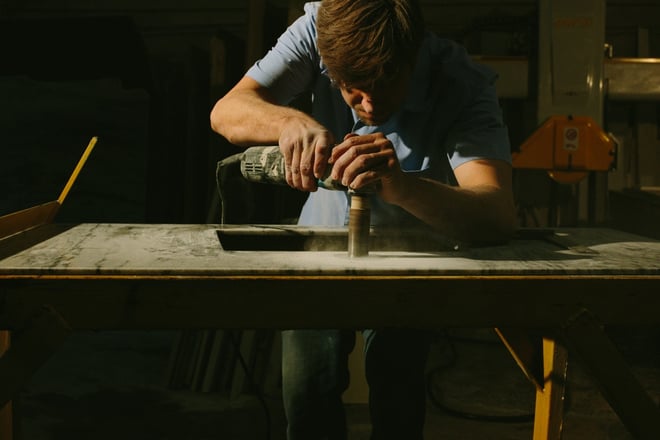
Has this scenario ever happened to you? A designer or homeowner walks into your shop with a cocktail napkin drawing for a kitchen design, with bookmatched slabs. Never mind the narrow hallways and small openings in the apartment or the fact that it calls for a material you’ve never worked with. You’ve got to find a way to make her vision a reality and get the project installed.
If a designer has asked you to work with a material like Polycor’s 1 cm Thin Stone you’re probably wondering what you’re in for as you turn a thin slab into a countertop with sink holes. And that’s what we’re going to tackle in today’s blog.
Thin Stone looks great. Sleek and sophisticated, it’s a designer’s dream. But how does it cut? What tools do you need for fabrication? Will it break during installation?
We’ve got the top frequently asked questions about 1 cm stone and the answers you need to fabricate Thin Stone.
First off, what is it?
Polycor’s ultra-thin 1 cm slabs are natural stone – marble or granite – sliced down to 3/8” and reinforced with a proprietary composite backing.
What’s the difference in fabrication of natural thin stone and manufactured materials like porcelain?
Some designers favor porcelain for uniformity and cost, but you know that working with it can be a nightmare with porcelain’s potential for snapping and it’s sharp, dangerous edges. Lighter and stronger than 3 cm, ultra-thin stone is far easier to handle and fabricate than porcelain (or thicker natural stone slabs).
Does Thin Stone require special handling?
Since 1 cm slabs are three times thinner than typical 3 cm slabs, they weigh a third less, making them easier to handle during fabrication and installation. (No pulling eight guys off a job to carry in a full slab fireplace wall or kitchen island.) You can even carry them flat!
We recommend carrying them stone side up or on edge for maximum strength.
Will it crack more easily than 3 cm?
No. In fact, both the natural marble and natural granite slabs have flexural strength 10x that of an unbacked 3 cm slab.
What tools do I need to fabricate it with?
There are no special tools required. Ultra-thin slabs are fabricated just like 3 cm or 2 cm stones. Standard segmented bridge saw and angle grinder diamond blades, silicon carbide sandpapers and stones, polishing pads and core bits are all you need.
What speed should I cut at?
Match the blade to the material and cut at a slightly slower traverse speed than you would a 2 cm stone. You’ll want to use plenty of water to make sure you’re not heating up the blade and chipping the stone. This applies when cleanly cutting any material.
How will cutting 1 cm affect my tools?
1 cm stone cuts cleanly and because of its slim profile, preserves blade life significantly over 2 and 3 cm stone. You’ll get more precision cuts with the same blade when cutting Thin Stone.
How do you finish thin slabs?
With the same tools and techniques you use with thicker granite and marble, except you’ll get it done much quicker. You’ll be able to speed through grinding the sink cutout shapes and it will take less time to polish the entire surface area of the edges, just a few passes and you’re done.
Are there any applications where 1 cm doesn’t work?
Although spans between two supports aren’t an issue, large unsupported cantilvers are not recommended. Don’t go for that 12” overhang like you usually do with 3 cm stone.
What’s the maximum overhang for Thin Stone slab?
A 1 cm installation can have up to 2 inches of unsupported overhang (we’ve done up to 4 inches in tests and have had good results too). You can go for a bigger overhang with brackets, corbels or other supports.
Can I use a mitered joint?
Yes, miters cut cleanly and hold up well (add glue blocks for more surface area contact). See our spec sheet for a list of edge possibilities.
Which stones come in 1 cm?
Polycor offers Thin Stone in all of our marble and granite, from White Cherokee Georgia marble to CAMBRIAN BLACK®granite. All sourced from our North American quarries.
What is the actual thickness of the ultra-thin stone slabs?
Thin Stone has a nominal thickness of 1 cm and an actual thickness of 3/8”.
Still have questions? Download our guide for fabricators.
